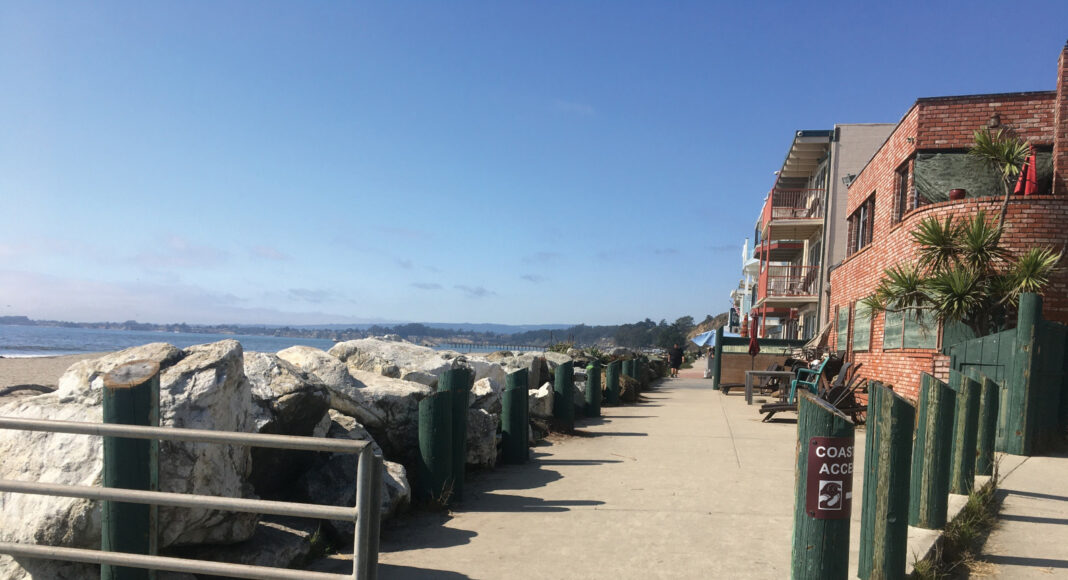A Santa Cruz County Superior Court Judge ruled on Oct. 8 that a group of Rio Del Mar property owners can put up temporary fencing blocking public access to a 37-foot-wide, 786-foot-long beachside walkway that runs along their properties.
County officials plan to appeal the ruling to the 6th District Court of Appeal.
Immediately after the ruling by Judge Timothy Volkman—which he tentatively made in June—the California Coastal Commission told the owners that, despite the verdict, the walkway must remain open under state law.
The walkway in question lies on the seaward side of a strip of homes from 202-300 Beach Drive.
The property owners—part of the Rio del Mar Beach Island Homeowners’ Association—say the walkway is their property.
The situation came to a boil in 2018 when the County removed a fence that blocked public access on one end of the walkway and a brick wall that partially blocked the other. That move followed months of back-and-forth with the County. That included threats of financial penalties.
Since then, the residents say that numerous people per day run, skateboard and bike along the walkway, which runs directly behind their residences. One resident says beachgoers used his patio for a bonfire, says Patrick Richard, an attorney representing the homeowners.
Many people peer into the windows of the residences, the ruling states, leaving residents to worry over their privacy and safety.
“The patio areas are rendered useless, as one cannot safely stand, nor sit in that area, with the presence of cyclists moving through,” it says.
Santa Cruz County spokesman Jason Hoppin says the issue is public access to the beachside walkway.
“These are a small number of wealthy homeowners along Beach Drive who don’t represent the rest of the community or even the rest of the homeowners there,” Hoppin says. “We will continue to fight for the public’s right to access the coast, including the disabled community and all users of this space.”
County Parks Friends Executive Director Mariah Roberts says that while blocking the walkway would not hinder access to the beach, it would impact people with disabilities.
People who use wheelchairs, she says, would be forced to use the narrow sidewalk on the street side of the homes.
“When you use a wheelchair, you already don’t have access to the sand,” she says. “When we talk about access, we talk about the ability to visit the beach and benefit from the views, the beauty, the places that the public owns.”
If the ruling stands, Roberts says, it could set a precedent that could impact access countywide.
Richard has a different take, saying that historically the strip of land has belonged to the residents.
According to Volkman’s ruling, County officials in 1958 said the County did not possess the title to the walkway and that it should be “abandoned.”
Moreover, property owners have used the area for private purposes since 1968, and the County has not spent any money to maintain the walkway since 1928.
In 2004, the County Assessor said the residents have been paying property taxes based on the area that includes the walkway and, as such, have “implied ownership,” the ruling states.
“I think the judge saw what anyone who looks at the whole arc of evidence sees, which is ‘wow, what an abuse of power,’” Richard says.
One resident who has owned one of the units since 1985—and who asked not to be named—says that County officials and the Coastal Commission forced her to tear out a patio her husband built that partly blocked the walkway and threatened her with $5,000 per day fines if she did not.
She now worries about safety, with bicyclists speeding by, although those are not the worst things she sees.
“We’ve had cars and motorcycles go up and down here; I’m not kidding you,” she says.
She says others walking their dogs don’t bother to clean up after them.
Still, she says that most passers-by are amicable, and she doesn’t want more barriers to be built.
“I don’t think they can, I don’t think they will, and I don’t think they should,” she says.





















What, no e-bikes?